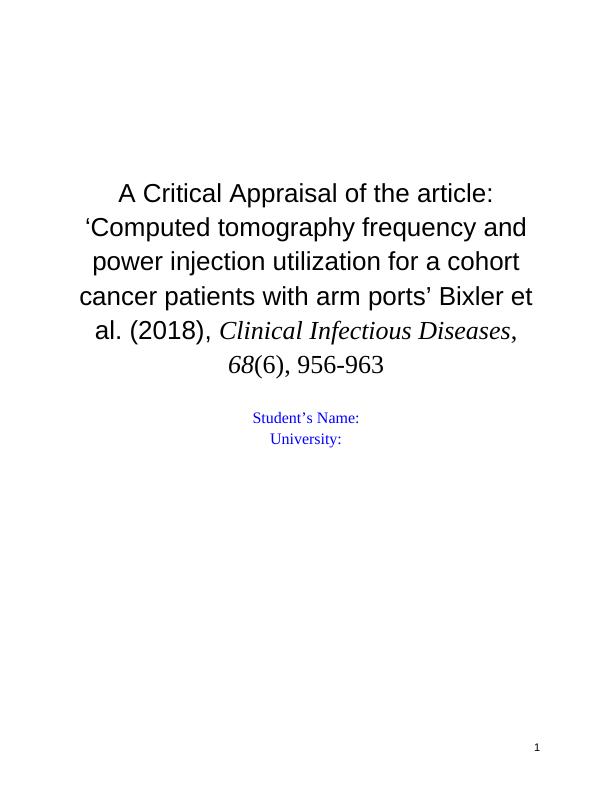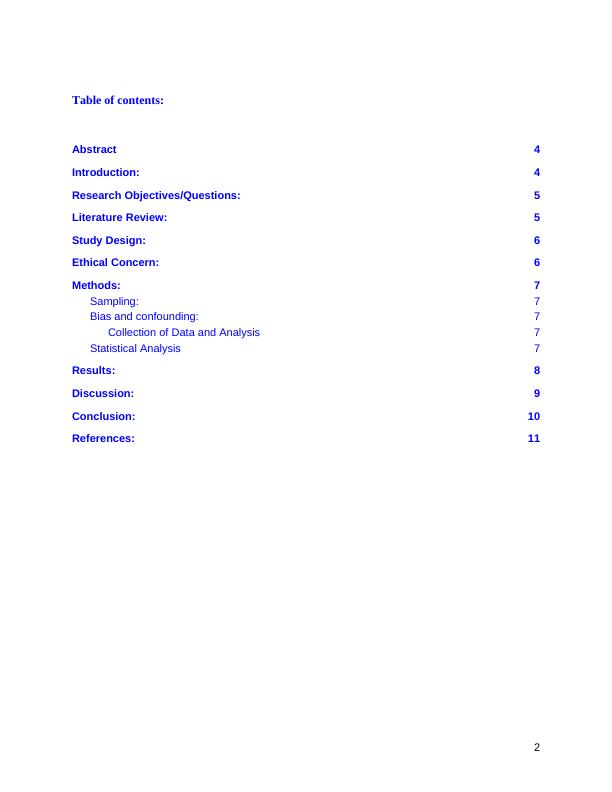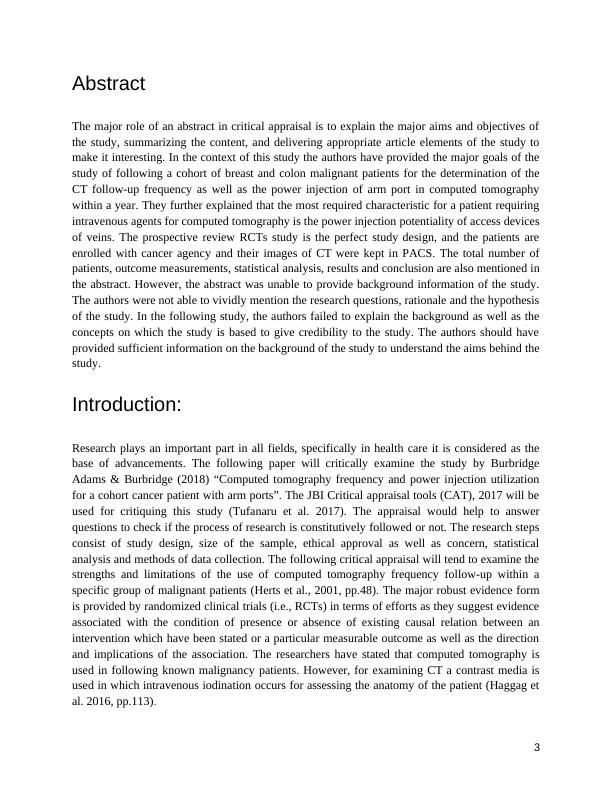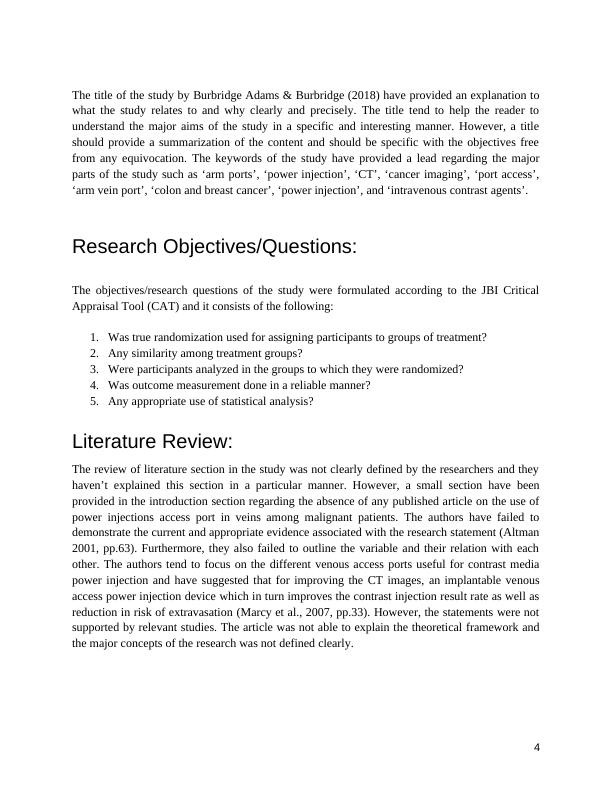Critical Appraisal of 'Computed Tomography Frequency and Power Injection Utilization for a Cohort Cancer Patients with Arm Ports'
Added on 2023-04-07
12 Pages3652 Words254 Views
A Critical Appraisal of the article:
‘Computed tomography frequency and
power injection utilization for a cohort
cancer patients with arm ports’ Bixler et
al. (2018), Clinical Infectious Diseases,
68(6), 956-963
Student’s Name:
University:
1
‘Computed tomography frequency and
power injection utilization for a cohort
cancer patients with arm ports’ Bixler et
al. (2018), Clinical Infectious Diseases,
68(6), 956-963
Student’s Name:
University:
1


Abstract
The major role of an abstract in critical appraisal is to explain the major aims and objectives of
the study, summarizing the content, and delivering appropriate article elements of the study to
make it interesting. In the context of this study the authors have provided the major goals of the
study of following a cohort of breast and colon malignant patients for the determination of the
CT follow-up frequency as well as the power injection of arm port in computed tomography
within a year. They further explained that the most required characteristic for a patient requiring
intravenous agents for computed tomography is the power injection potentiality of access devices
of veins. The prospective review RCTs study is the perfect study design, and the patients are
enrolled with cancer agency and their images of CT were kept in PACS. The total number of
patients, outcome measurements, statistical analysis, results and conclusion are also mentioned in
the abstract. However, the abstract was unable to provide background information of the study.
The authors were not able to vividly mention the research questions, rationale and the hypothesis
of the study. In the following study, the authors failed to explain the background as well as the
concepts on which the study is based to give credibility to the study. The authors should have
provided sufficient information on the background of the study to understand the aims behind the
study.
Introduction:
Research plays an important part in all fields, specifically in health care it is considered as the
base of advancements. The following paper will critically examine the study by Burbridge
Adams & Burbridge (2018) “Computed tomography frequency and power injection utilization
for a cohort cancer patient with arm ports”. The JBI Critical appraisal tools (CAT), 2017 will be
used for critiquing this study (Tufanaru et al. 2017). The appraisal would help to answer
questions to check if the process of research is constitutively followed or not. The research steps
consist of study design, size of the sample, ethical approval as well as concern, statistical
analysis and methods of data collection. The following critical appraisal will tend to examine the
strengths and limitations of the use of computed tomography frequency follow-up within a
specific group of malignant patients (Herts et al., 2001, pp.48). The major robust evidence form
is provided by randomized clinical trials (i.e., RCTs) in terms of efforts as they suggest evidence
associated with the condition of presence or absence of existing causal relation between an
intervention which have been stated or a particular measurable outcome as well as the direction
and implications of the association. The researchers have stated that computed tomography is
used in following known malignancy patients. However, for examining CT a contrast media is
used in which intravenous iodination occurs for assessing the anatomy of the patient (Haggag et
al. 2016, pp.113).
3
The major role of an abstract in critical appraisal is to explain the major aims and objectives of
the study, summarizing the content, and delivering appropriate article elements of the study to
make it interesting. In the context of this study the authors have provided the major goals of the
study of following a cohort of breast and colon malignant patients for the determination of the
CT follow-up frequency as well as the power injection of arm port in computed tomography
within a year. They further explained that the most required characteristic for a patient requiring
intravenous agents for computed tomography is the power injection potentiality of access devices
of veins. The prospective review RCTs study is the perfect study design, and the patients are
enrolled with cancer agency and their images of CT were kept in PACS. The total number of
patients, outcome measurements, statistical analysis, results and conclusion are also mentioned in
the abstract. However, the abstract was unable to provide background information of the study.
The authors were not able to vividly mention the research questions, rationale and the hypothesis
of the study. In the following study, the authors failed to explain the background as well as the
concepts on which the study is based to give credibility to the study. The authors should have
provided sufficient information on the background of the study to understand the aims behind the
study.
Introduction:
Research plays an important part in all fields, specifically in health care it is considered as the
base of advancements. The following paper will critically examine the study by Burbridge
Adams & Burbridge (2018) “Computed tomography frequency and power injection utilization
for a cohort cancer patient with arm ports”. The JBI Critical appraisal tools (CAT), 2017 will be
used for critiquing this study (Tufanaru et al. 2017). The appraisal would help to answer
questions to check if the process of research is constitutively followed or not. The research steps
consist of study design, size of the sample, ethical approval as well as concern, statistical
analysis and methods of data collection. The following critical appraisal will tend to examine the
strengths and limitations of the use of computed tomography frequency follow-up within a
specific group of malignant patients (Herts et al., 2001, pp.48). The major robust evidence form
is provided by randomized clinical trials (i.e., RCTs) in terms of efforts as they suggest evidence
associated with the condition of presence or absence of existing causal relation between an
intervention which have been stated or a particular measurable outcome as well as the direction
and implications of the association. The researchers have stated that computed tomography is
used in following known malignancy patients. However, for examining CT a contrast media is
used in which intravenous iodination occurs for assessing the anatomy of the patient (Haggag et
al. 2016, pp.113).
3

The title of the study by Burbridge Adams & Burbridge (2018) have provided an explanation to
what the study relates to and why clearly and precisely. The title tend to help the reader to
understand the major aims of the study in a specific and interesting manner. However, a title
should provide a summarization of the content and should be specific with the objectives free
from any equivocation. The keywords of the study have provided a lead regarding the major
parts of the study such as ‘arm ports’, ‘power injection’, ‘CT’, ‘cancer imaging’, ‘port access’,
‘arm vein port’, ‘colon and breast cancer’, ‘power injection’, and ‘intravenous contrast agents’.
Research Objectives/Questions:
The objectives/research questions of the study were formulated according to the JBI Critical
Appraisal Tool (CAT) and it consists of the following:
1. Was true randomization used for assigning participants to groups of treatment?
2. Any similarity among treatment groups?
3. Were participants analyzed in the groups to which they were randomized?
4. Was outcome measurement done in a reliable manner?
5. Any appropriate use of statistical analysis?
Literature Review:
The review of literature section in the study was not clearly defined by the researchers and they
haven’t explained this section in a particular manner. However, a small section have been
provided in the introduction section regarding the absence of any published article on the use of
power injections access port in veins among malignant patients. The authors have failed to
demonstrate the current and appropriate evidence associated with the research statement (Altman
2001, pp.63). Furthermore, they also failed to outline the variable and their relation with each
other. The authors tend to focus on the different venous access ports useful for contrast media
power injection and have suggested that for improving the CT images, an implantable venous
access power injection device which in turn improves the contrast injection result rate as well as
reduction in risk of extravasation (Marcy et al., 2007, pp.33). However, the statements were not
supported by relevant studies. The article was not able to explain the theoretical framework and
the major concepts of the research was not defined clearly.
4
what the study relates to and why clearly and precisely. The title tend to help the reader to
understand the major aims of the study in a specific and interesting manner. However, a title
should provide a summarization of the content and should be specific with the objectives free
from any equivocation. The keywords of the study have provided a lead regarding the major
parts of the study such as ‘arm ports’, ‘power injection’, ‘CT’, ‘cancer imaging’, ‘port access’,
‘arm vein port’, ‘colon and breast cancer’, ‘power injection’, and ‘intravenous contrast agents’.
Research Objectives/Questions:
The objectives/research questions of the study were formulated according to the JBI Critical
Appraisal Tool (CAT) and it consists of the following:
1. Was true randomization used for assigning participants to groups of treatment?
2. Any similarity among treatment groups?
3. Were participants analyzed in the groups to which they were randomized?
4. Was outcome measurement done in a reliable manner?
5. Any appropriate use of statistical analysis?
Literature Review:
The review of literature section in the study was not clearly defined by the researchers and they
haven’t explained this section in a particular manner. However, a small section have been
provided in the introduction section regarding the absence of any published article on the use of
power injections access port in veins among malignant patients. The authors have failed to
demonstrate the current and appropriate evidence associated with the research statement (Altman
2001, pp.63). Furthermore, they also failed to outline the variable and their relation with each
other. The authors tend to focus on the different venous access ports useful for contrast media
power injection and have suggested that for improving the CT images, an implantable venous
access power injection device which in turn improves the contrast injection result rate as well as
reduction in risk of extravasation (Marcy et al., 2007, pp.33). However, the statements were not
supported by relevant studies. The article was not able to explain the theoretical framework and
the major concepts of the research was not defined clearly.
4

End of preview
Want to access all the pages? Upload your documents or become a member.
Related Documents
Effectiveness of the Ultrasound Technique in the Detection of Breast Cancer and Other Congenital Anomalieslg...
|13
|3458
|409
What is electronic health record (EHR)?lg...
|4
|761
|10
BRFSS Refers to Behavioural Risklg...
|4
|1129
|14
Critical Appraisal (Paraphrasing)lg...
|8
|2184
|20
Role of Cross-Sectional Imaging in Diagnosis and Treatment of Hepatocellular Carcinomalg...
|17
|4138
|100
Statistical Analysis on Clinical Triallg...
|15
|2819
|40
